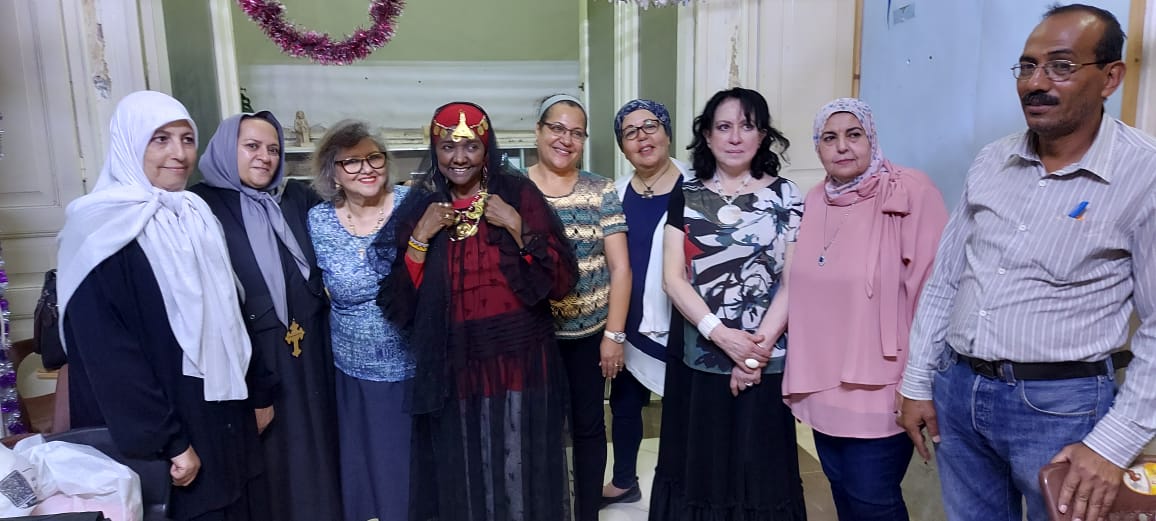Exclusive – Ramy Elhadary
Nubia in Egypt is a life that endures despite all challenges. Under the title “The Flavor of Nubian Houses,” researcher Ezza Abdo Saeed, a native of Abu Simbel village and head of the Culture Committee at the General Nubian Club, spoke about the lives, history, and culture of the Nubian people in a seminar attended by 7eNEWS and organized by the Egyptian Heritage Conservation Association under the sponsorship of the association’s president, Engineer Majed El Raheb.
Ezza Saeed discussed the details of Nubian life in the southernmost part of Egypt, explaining that life begins in the Nubian house. The house consists of six rooms and a courtyard in the middle. It includes the “Mandara,” which is a room for receiving guests, and the “Diwani,” where the groom lives after his wedding night. There is also a room for baking called the Baking Room and another room for dining called the Oven. Additionally, there is a room for storing supplies known as the “Muan,” and finally, a room for keeping birds that are raised by the housewife.
Nubians have a distinctive style of clothing. Women and girls wear the “Jarjar” which is a transparent black fabric. As for men, their traditional attire is the “Araki,” which is a lightweight white fabric similar to a long shirt. This is a summer outfit. There are also white “Jellabiya” and turbans that are worn on holidays, special occasions, and weddings. Men generally wear them at home as well.

Ezza Saeed mentions that Nubians have their own special foods. One of them is “Aish-Khubroz” (Kabed), which is a thick, crepe-like bread. They also have “Al-Intar,” which is a dish made with greens and onions, similar to mulukhiyah. There is also “Aish-Khubroz” (Shady), which is lighter than “Kabed” and is eaten with ground okra. Another type is “Aish-Khubroz” (Salabah), which is a light, yeast-based bread eaten with yogurt and buttermilk. It is a staple in Nubian cuisine, unlike “Kishk” and noodles with yogurt. There is also a type called “Karm Muraid.”
Ezza Saeed says that gold has a special significance in the life of Nubian women. It comes in five forms and resembles Pharaonic gold in terms of the engravings on it. It is of 24-carat purity. The first form is “Al-Rassa” which is worn on the head along with a pendant called “Gasse al-Rahman.” Then there is “Al-Safa,” which is worn around the neck, and “Jakid” is worn beneath the neck. “Shaf” is worn beneath the “Jakid” and above the chest. Finally, there is “Al-Beiah” which is worn beneath the “Shaf” to cover the lower part of the chest.
She indicates that the five types of gold are worn all together by women and girls, especially married ones, to cover the chest and reach the abdomen.

The researcher moves on to talk about “Henna” in the lives of the Nubians, which is used by Nubian brides on their wedding night to adorn themselves. It differs for other girls, as it is applied on their hands up to the elbows and on their feet up to the knees. Unmarried girls, however, do not draw henna on their legs and only apply it on their hands. These are customs and traditions that the people of Nubia still hold onto.
In the lives of the Nubian people, there is a traditional practice of herbal remedies. When a man, woman, or child falls ill, they undergo a process called “Al-Wartab.” It involves making small incisions on the back of the person, specifically at the fatty part of the body, using a sharp knife to release dark blood. It is believed that this blood is impure. The process of making incisions is repeated until the blood turns red. Afterward, the patient consumes a cup of “Hilf al-Br,” which is a drink made from an authentic Nubian Pharaonic plant.
Ezza Saeed highlights the role of “Al-Khous” (palm leaf) in the lives of the Nubian people. She explains that palm leaves are used to craft essential household items in Nubian homes. One notable item is “Al-Shawer,” a large colorful dish made from palm leaves, which is used to cover food trays when serving meals. There are also smaller variations of palm leaf plates used for serving dates, dried fruits, and popcorn. Furthermore, both large and small palm leaf plates are utilized as decorative elements on the walls of Nubian houses.
The researcher, Aza Said, also discussed the traditional folk games of the Nubian people, including “Al-Handakiya,” “Jisr Kadiya,” “Shabr Shabren,” “Kunkalia,” and “Al-Tab.” These games involve skill and quick decision-making.


















